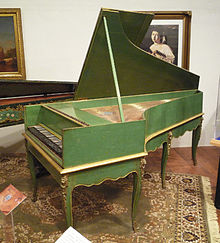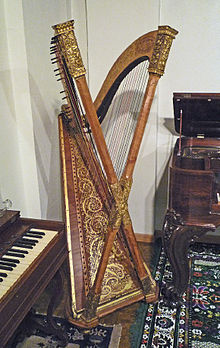- National Music Museum
-
This article is about a museum in the United States. For other museums, see Musical Instrument Museum.
The National Music Museum: America's Shrine to Music & Center for Study of the History of Musical Instruments (NMM) is a musical instrument museum in Vermillion, South Dakota, USA. It was founded in 1973 on the campus of the University of South Dakota. The NMM is fully accredited by the American Association of Museums and is recognized as "A Landmark of American Music" by the National Music Council.
The NMM's renowned collections, which include more than 13,500 American, European, and non-Western instruments from all cultures and historical periods, are among the world's most inclusive. They include many of the earliest, best preserved, and historically most important instruments known to survive. The quality and scope of the NMM has earned it international recognition.
Contents
Background
 Grand piano by Louis Bas of Villeneuve-lès-Avignon, France, 1781. Earliest French grand piano known to survive; includes an inverted wrestplank and action derived from the work of Bartolomeo Cristofiori (ca. 1700) with ornately decorated soundboard.
Grand piano by Louis Bas of Villeneuve-lès-Avignon, France, 1781. Earliest French grand piano known to survive; includes an inverted wrestplank and action derived from the work of Bartolomeo Cristofiori (ca. 1700) with ornately decorated soundboard.
The NMM was founded as a partnership between The University of South Dakota, which provides staff and facilities for preservation, teaching, and research, and the Board of Trustees of the NMM, a non-profit, 501(c)(3) corporation that is responsible for acquisitions, public exhibiting, and programming. The Board of Trustees is completely dependent upon support from NMM members, individuals, corporations, foundations, and governmental units.
The NMM is housed in a fully accessible, climate-controlled building, where 850 representative instruments are exhibited in nine galleries. The Arne B. Larson Concert Hall has superb acoustics and provides a perfect setting for performing and recording music played on original instruments of various historical periods and cultural milieu. There is a specialized library, extensive study-storage areas, and a laboratory for the conservation and restoration of the instruments. There are violin-making tools and Baroque fittings, early harpsichord and fortepiano tuning hammers, and 1,000 brass instrument mouthpieces from virtually every turn-of-the-century manufacturer.
It also has rich holdings of related objects and archival materials, such as the unequaled Salabue-Fiorini-De Wit-Hermann-Witten-Rawlins Collection of 650 violin makers' labels. The American musical instrument manufacturers archives is the largest of its kind. Scholars from around the world make frequent use of the NMM's collections and facilities, providing an important opportunity for students to meet and work with individuals on the latest scholarship on musical research.
Collection
 Double chromatic harp, built ca. 1890 by Henry Greenway, Brooklyn, New York; one of two extant instruments of this type.
Double chromatic harp, built ca. 1890 by Henry Greenway, Brooklyn, New York; one of two extant instruments of this type.
The NMM is the only place in the world where one can find two 18th-century grand pianos with the specific type of action conceived by the piano's inventor, Bartolomeo Cristofori. One of these built in 1767 by Manuel Antunes of Lisbon, is the earliest signed and dated piano by a maker native to Portugal; the other, built by Louis Bas in Villeneuve-lès-Avignon in 1781, is the earliest extant French grand piano.
Other extraordinary keyboards include a Neapolitan virginal (ca. 1520), three 17th-century Flemish harpsichords (two by Andreas Ruckers), 17th- and 18th-century English, German, Portuguese, and French harpsichords, and German and Swedish clavichords.
A group of 500 instruments made in the late-19th-, early-20th centuries by the C. G. Conn Company of Elkhart, Indiana, is a resource unparalleled anywhere for historical research about a major American industry and the American band movement.
The NMM's holdings by 17th- and 18th-century Nürnberg makers of wind instruments, including members of the Denner, Ehe, Haas, Oberlender, and Steinmetz families, as well as Ernst Busch, Paul Hainlein, Johann Benedikt Gahn, Johann Carl Kodisch, Leonhard Maussiel, Michael Nagel, and Paulus Schmidt, are unique outside of Germany.
The NMM's holdings of 17th- and 18th-century Dutch woodwind instruments by such makers as Richard Haka (represented here by a soprano recorder made ca. 1690), Hendrik Richters, Philip Borkens, and Abraham van Aardenberg is unique outside of the Netherlands.
The Witten-Rawlins Collection of early Italian stringed instruments crafted by Andrea Guarneri, Antonio Stradivari, three generations of the Amati family, and others by far surpasses any in Italy. Included are two of only three, 17th-century Cremonese stringed instruments preserved in the world today in unaltered condition. Additionally, the NMM preserves one of only two Stradivari guitars to be seen in a museum setting, and one of only two Stradivari mandolins known to survive.
The sum of these groups of American, Dutch, German, and Italian instruments is to be found nowhere else.
The 1994 addition of the John Powers Saxophone Collection (Aspen, Colorado) and the Cecil Leeson Saxophone Collection and Archives (transferred from Ball State University) make the NMM the preeminent center for studying the history of the saxophone.
The 1996 addition of the Rosario Mazzeo (Carmel, California) and the Bill Maynard (Massapequa, New York) Clarinet Collections make the NMM the preeminent center for studying the clarinet.
The 1999 addition of the Joe & Joella Utley (Spartanburg, South Carolina) Collection and the establishment of the Utley Institute for Brass Studies makes the NMM the preeminent center for studying the history of brass instruments.
The Alan Bates Harmonica Collection and Archives (Wilmington, Delaware), received as a gift in 2000, is second in size and importance only to the Harmonika Museum in Trossingen, Germany.
The 2005 gift of the D'Angelico, D'Aquisto, Gudelsky Workshop was the focus of a major exhibition, "Great American Guitars" (by D'Angelico, D'Aquisto, Fender, Gibson, Martin, and Stromberg-Voisinet).
In April 2007, the Museum outbid New York's Metropolitan Museum of Art at a Christie's auction in acquiring a rare English cittern dating from the late 16th century, "This instrument is extremely rare, probably the only English cittern from the Renaissance known to survive," Museum Director Andre Larson said. "We already have an Italian cittern from the same period, but it's one of two or three that have survived."
See also
External links
- National Music Museum website
- The Renaissance Cittern Site: Informational page about the NMM English cittern
Coordinates: 42°46′58″N 96°55′35″W / 42.782839°N 96.926354°W
Categories:- Museums established in 1973
- University museums in South Dakota
- University of South Dakota
- Music museums in the United States
- History museums in South Dakota
- Museums in Clay County, South Dakota
- Musical instrument museums in the United States
- American national museums in South Dakota
- Institutions accredited by the American Association of Museums
Wikimedia Foundation. 2010.

